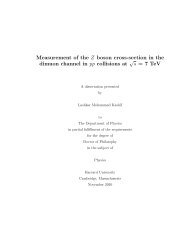2 The CDF Experiment at Fermilab Contents - Harvard University ...
2 The CDF Experiment at Fermilab Contents - Harvard University ...
2 The CDF Experiment at Fermilab Contents - Harvard University ...
You also want an ePaper? Increase the reach of your titles
YUMPU automatically turns print PDFs into web optimized ePapers that Google loves.
68 Section 2: <strong>CDF</strong> Physics Analysis<br />
Figure 33: <strong>The</strong> pp ! WW cross section measured by <strong>CDF</strong> <strong>at</strong> 1:8 TeV compared to theory<br />
predictions.<br />
W + production. Another interesting diboson process is W production. <strong>CDF</strong> has<br />
measured the cross section of this process using the leptonic decay mode of the W [19], but<br />
no serious eort has been made in the more challenging hadronic channel. Here the d<strong>at</strong>a<br />
sample is the high E T photon sample, and the primary backgrounds are + 2 jet production<br />
and fake photons from neutral hadrons. Hall and Dorigo have begun looking <strong>at</strong> the Run I<br />
d<strong>at</strong>a to determine if it is feasible to observe W 's in this sample. If a signal is found its peak<br />
position can be used to set the energy scale for the calorimetry. Also any experience we can<br />
gain with hadronic W decays will be useful in other rel<strong>at</strong>ed analyses.<br />
Trileptons, and Same-Sign Dileptons. <strong>The</strong> appearance of WW and WZ events in purely<br />
leptonic nal st<strong>at</strong>es is interesting, too. Schmitt identied events with three leptons (`trileptons')<br />
or two leptons with the same sign (`same-sign dileptons') as sensitivechannels for higgs<br />
bosons of intermedi<strong>at</strong>e mass (M h > 135 GeV). This comes about through pp ! Wh followed<br />
by h ! WW () , which domin<strong>at</strong>es for M h > 135 GeV. If all three W 's decay to leptons,<br />
then a very clean topology results. (This topology has been studied already in the context<br />
of a search for associ<strong>at</strong>ed chargino and neutralino production.) Schmitt has developed an<br />
eective set of selection criteria. Some examples of his cuts are shown in Fig. 34<br />
A second clean topology arises when the two W 's with the same charge decay leptonically<br />
with the third decaying hadronically. This topology is called the `same-sign dilepton'<br />
topology, and due to the higher r<strong>at</strong>e, is more powerful than the trilepton topology. Schmitt















